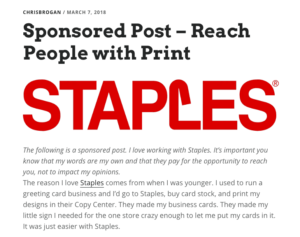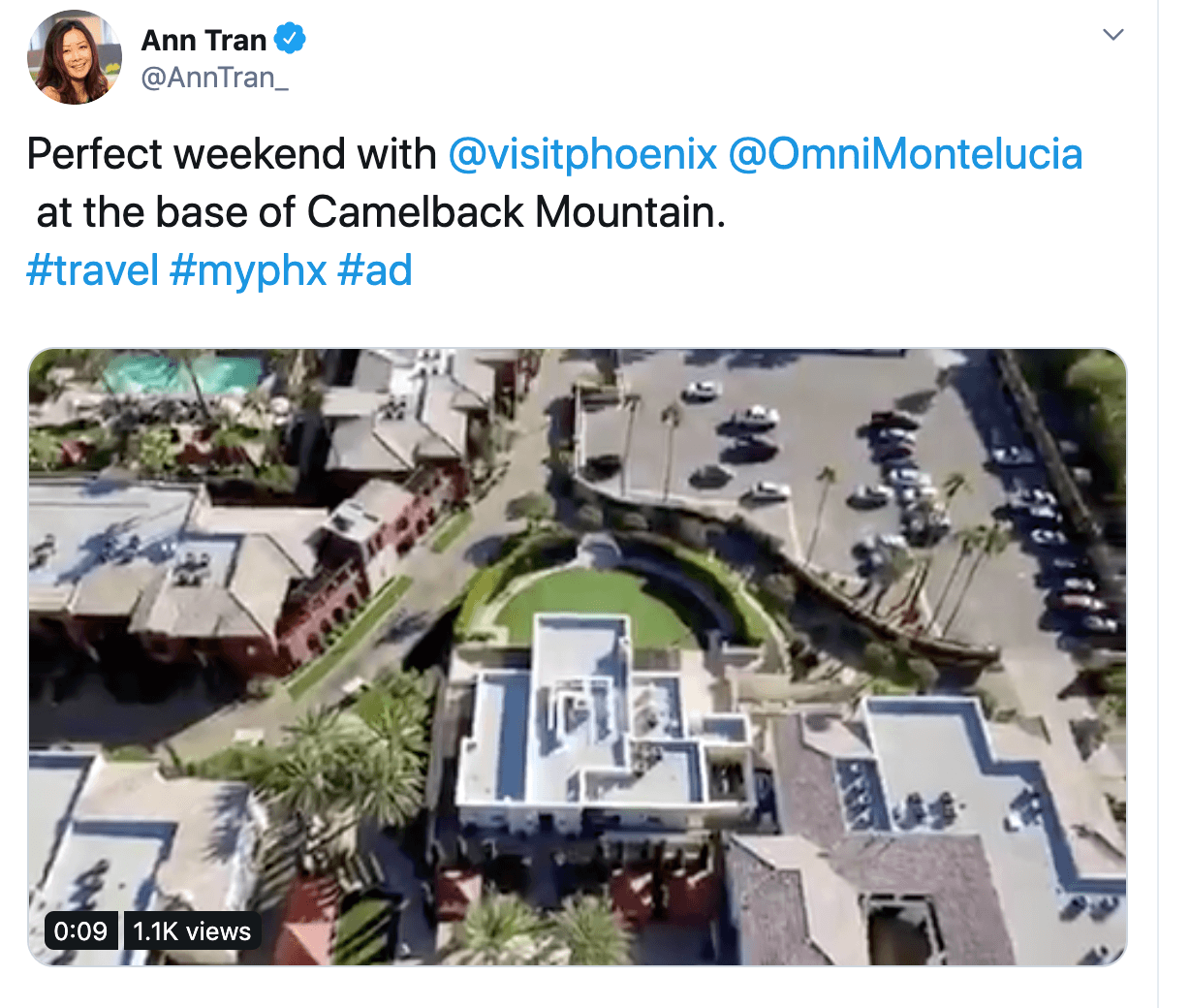
Since 2012, Kerry Gorgone has been a regular columnist here on the {grow} blog. I’m sad to say that this is her last post — at least for a while — as she adjusts to new responsibilities and a new job. Kerry has brought so much value to the readers on {grow} and we will miss her!
By Kerry Gorgone, {grow} Contributing Columnist
Whether you love it or hate it, influencer marketing works.
It works so well, in fact, that the FDA recently expressed concern over influencers hawking pharmaceuticals. If people are trying prescription drugs on the recommendation of an influencer, you’d better make sure they know if that influencer’s on your payroll (or even if he/she received a free examination or sample medication).
The law (enforced by the Federal Trade Commission) requires that influencers “disclose when [the influencer has] any financial, employment, personal, or family relationship with a brand,” and further observes that “financial relationships aren’t limited to money.” The crux of the matter is that influencers must “disclose the relationship” if they receive “anything of value to mention a product.” (Emphasis added.)
In the interest of helping you keep your influencer marketing legal, especially in light of new FTC guidelines, here are some pointers if you are in a position to lead influencer marketing for your company.
1. Disclosures must be visible (Even on mobile)
In the age of mobile, it’s necessary to view sponsored posts on different devices and using different browsers to ensure that disclosures are visible without the viewer having to scroll, pinch the screen to zoom or click away.
Big screen or small, disclosures must be viewable. If you are in a position to lead an influencer marketing effort you must know that it’s also a brand’s responsibility to make sure that any influencers you work with comply with FTC requirements.
2. Remember “The 4 P’s of Disclosure”
- Placement: Place disclosures near the claim they’re qualifying.
- Proximity: Users shouldn’t have to scroll or zoom to see disclosure, even on mobile.
- Prominence: Make it pop. Think about how those tacky “MySpace” pages used to look, with big fonts, lots of colors, flame effects… Your disclosures need to be that noticeable.
- Presentation Order: Make the disclosure “unavoidable,” so that consumers will absolutely see it before they can click away to any product page, landing page, eCommerce site, etc.
You need to make sure people are looking at disclosures because if they aren’t, you’re responsible. Check analytics, test all web pages and view all social posts on multiple browsers and devices. Make sure all disclosures are visible without clicking, scrolling, or zooming.
On Instagram, this means disclosures should be visible right away, without clicking “more” to expand the caption.
The FTC has made it clear that space-constrained ads or sponsored posts (even on character-restricted platforms like Twitter) still have to comply. In short, if you can’t fit disclosure on the platform, your influencers shouldn’t use it to promote your brand.
3. Disclose, disclose, and disclose again
The FTC tells us that you can’t assume that people will read posts in order, so you need to disclose with each new post.
This means that if your brand is sponsoring a Twitter chat, the influencer hosting it needs to mention each time that this conversation is sponsored. If you’re sponsoring a series of videos, the on-camera influencer needs to mention the sponsored nature of the relationship in every single video.
4. No legalese required
The main objective is to make sure that an average person—one not familiar with influencer marketing or sponsored content—would understand that there’s a connection between the influencer and the company.
This could be as simple as saying “Acme sent me a free case of widgets for me to try” or “Beta Corp. paid my travel expenses so I could cover the opening of their new location in Bora Bora.”
So long as everyone reading would be clear on the fact that you got something from the brand (even if it’s just a free sample), you’re effectively disclosing. They can then decide how much weight to give your opinion in light of those facts.
5. Skip the hashtag
You might have seen #Ad or #SPON or #Sponsored on tweets, LinkedIn posts, Instagram, or anywhere else on social. The FTC has specifically said that “#SPON” is not clear enough. Most people don’t know, first, that “spon” is short for “sponsored,” let alone that “sponsored” implies you received something from the company in exchange for posting.
There’s no magical legal status granted to a post because you used a hashtag: just be clear about the relationship between the influencer and the brand. This might mean the post says something like “so excited to be working with Acme to launch their new line of widgets,” or “my employer, Beta Corporation, is hosting a FREE webinar tomorrow on widget management and it’s going to ROCK.”
Forget the hashtags and focus on simple language that gets the point across.
Best-selling author and StoryLeader creator Chris Brogan does a fantastic job disclosing when he creates sponsored content:

Travel blogger and social media consultant Ann Tran also makes sure to label sponsored content, even if it’s a single tweet.

6. Show and tell
On YouTube (or any other video platform), include the disclosure in the video description (the area visible before people expand to read the full text), but also include the disclosure in the video itself. Ideally, you want to both say and show the disclosure, multiple times, because people will watch some parts and not others and you don’t want them to miss it.
If you’re live streaming, you might not be able to visually reinforce the disclosure by including graphics or titles, but you can at least repeat the disclosure every few minutes, starting at the beginning and continuing through to the very end.
Here’s a timeline of how the FTC has progressed in terms of expressing and enforcing disclosure requirements for influencers, with links to additional resources.
March 2013, FTC clarified disclosure requirements for bloggers:
http://www.ftc.gov/opa/2013/03/dotcom.shtm
September 2017, FTC updated its endorsement guidelines “What People Are Asking” section:
https://www.ftc.gov/tips-advice/business-center/guidance/ftcs-endorsement-guides-what-people-are-asking
November 2019, FTC releases advertising disclosures guidance for online influencers
Announcement with links:
https://www.ftc.gov/news-events/press-releases/2019/11/ftc-releases-advertising-disclosures-guidance-online-influencers
Guide for Influencers (PDF):
https://www.ftc.gov/system/files/documents/plain-language/1001a-influencer-guide-508_1.pdf
Use influencer marketing. In the midst of the ongoing Marketing Rebellion, it’s an effective way to become part of social conversations and reach otherwise unreachable consumers. Just use influencer marketing responsibly!
 Kerry O’Shea Gorgone is a writer, lawyer, speaker and educator. She’s also a Learning Designer at MarketingProfs. Kerry hosts the weekly Marketing Smarts podcast and gets people to open up about their cool collections, weird hobbies, and inspiring side hustles on Punch Out With Katie and Kerry with co-host Katie Robbert. Find Kerry on Twitter. I
Kerry O’Shea Gorgone is a writer, lawyer, speaker and educator. She’s also a Learning Designer at MarketingProfs. Kerry hosts the weekly Marketing Smarts podcast and gets people to open up about their cool collections, weird hobbies, and inspiring side hustles on Punch Out With Katie and Kerry with co-host Katie Robbert. Find Kerry on Twitter. I
llustration courtesy Unsplash.com


